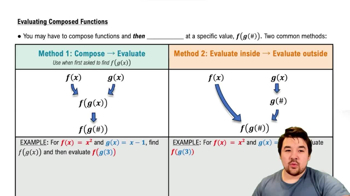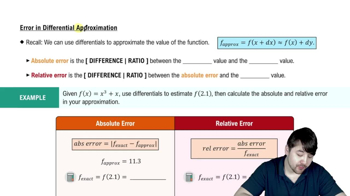Table of contents
- 0. Functions7h 52m
- Introduction to Functions16m
- Piecewise Functions10m
- Properties of Functions9m
- Common Functions1h 8m
- Transformations5m
- Combining Functions27m
- Exponent rules32m
- Exponential Functions28m
- Logarithmic Functions24m
- Properties of Logarithms34m
- Exponential & Logarithmic Equations35m
- Introduction to Trigonometric Functions38m
- Graphs of Trigonometric Functions44m
- Trigonometric Identities47m
- Inverse Trigonometric Functions48m
- 1. Limits and Continuity2h 2m
- 2. Intro to Derivatives1h 33m
- 3. Techniques of Differentiation3h 18m
- 4. Applications of Derivatives2h 38m
- 5. Graphical Applications of Derivatives6h 2m
- 6. Derivatives of Inverse, Exponential, & Logarithmic Functions2h 37m
- 7. Antiderivatives & Indefinite Integrals1h 26m
- 8. Definite Integrals4h 44m
- 9. Graphical Applications of Integrals2h 27m
- 10. Physics Applications of Integrals 2h 22m
4. Applications of Derivatives
Differentials
Problem 4.8.31
Textbook Question
{Use of Tech} Finding intersection points Use Newton’s method to approximate all the intersection points of the following pairs of curves. Some preliminary graphing or analysis may help in choosing good initial approximations.
y = 4√x and y = x² + 1
 Verified step by step guidance
Verified step by step guidance1
Step 1: Set the equations equal to each other to find the intersection points. This means solving 4√x = x² + 1.
Step 2: Rearrange the equation to form a function f(x) = 4√x - x² - 1. This function represents the difference between the two curves.
Step 3: Use preliminary graphing or analysis to estimate initial guesses for the intersection points. Look for values of x where the curves appear to intersect.
Step 4: Apply Newton's method to approximate the intersection points. Newton's method uses the formula x_{n+1} = x_n - f(x_n)/f'(x_n), where f'(x) is the derivative of f(x).
Step 5: Calculate the derivative f'(x) = (2/x^(1/2)) - 2x. Use this derivative in Newton's method to iteratively refine your initial guesses until the values converge to the intersection points.
 Verified video answer for a similar problem:
Verified video answer for a similar problem:This video solution was recommended by our tutors as helpful for the problem above
Video duration:
8mPlay a video:
Was this helpful?
Key Concepts
Here are the essential concepts you must grasp in order to answer the question correctly.
Newton's Method
Newton's Method is an iterative numerical technique used to find approximate solutions to equations. It starts with an initial guess and refines it using the formula x_{n+1} = x_n - f(x_n)/f'(x_n), where f is the function and f' is its derivative. This method is particularly useful for finding roots of functions, making it ideal for determining intersection points of curves.
Recommended video:

Evaluating Composed Functions
Intersection Points
Intersection points occur where two curves meet, meaning their y-values are equal for the same x-value. To find these points, one typically sets the equations of the curves equal to each other and solves for x. The solutions can then be substituted back into either original equation to find the corresponding y-values.
Recommended video:

Critical Points
Graphing and Analysis
Preliminary graphing and analysis involve plotting the functions to visually identify potential intersection points. This step helps in selecting appropriate initial guesses for Newton's Method, as the method's success often depends on starting close to the actual root. Understanding the behavior of the curves can also provide insights into the number and nature of intersection points.
Recommended video:

Graphing The Derivative







